#monk in athens
Explore tagged Tumblr posts
Text
They need to make a lipstick the color of red wine with coca-cola mmm
19 notes
·
View notes
Text
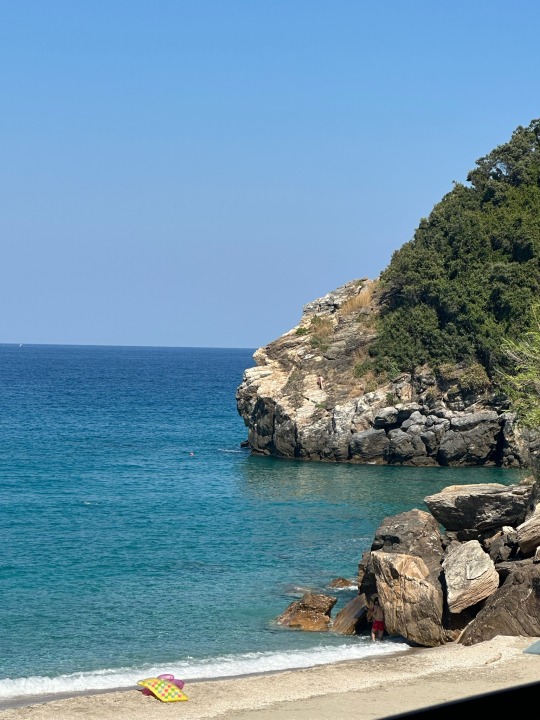
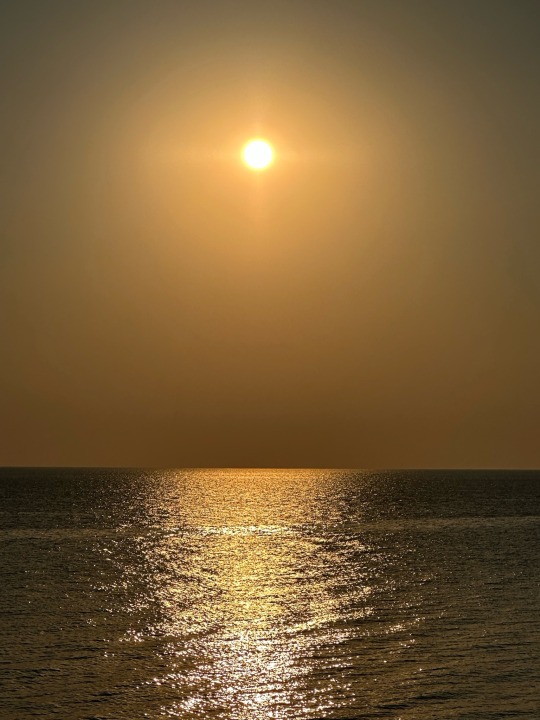
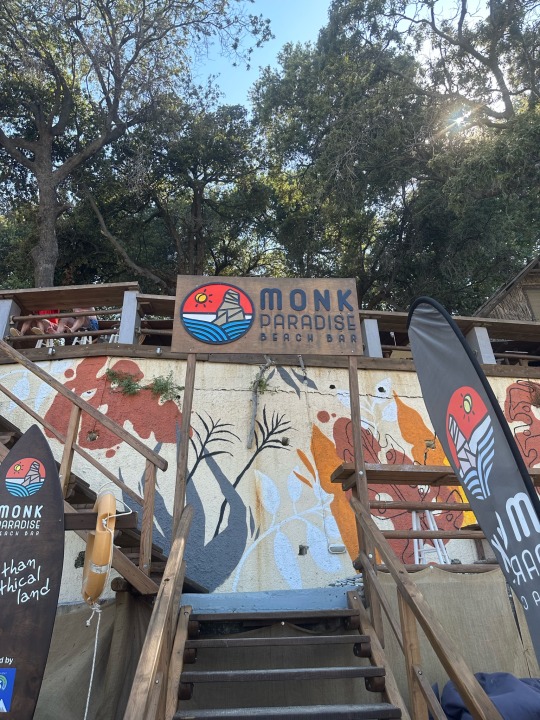
Ονειρα για ένα εξοχικό στο Πηλιο :)<3
#greek tumblr#love#athens#γκρικ ταμπλερ#kalokairi#sagapw#συναυλιες#volos#greece#rose#πηλιο#pelion#monk#vacayvibes#συναισθήματα#vacation#παραλία#θαλασσα#σε αγαπαω#θασεπεριμενω
31 notes
·
View notes
Text



This monk from the Gregoriou Monastery on Mount Athos sleeps on a park bench in Athens and is the priest and spiritual father of the homeless.
134 notes
·
View notes
Text
TIL from a podcast featuring historian and Byzantine archaeologist Yannis Theoharis:
Athens was one of the most religiously conservative cities of the Byzantine Empire. It adhered to the ancient Greek religion for longer than most other areas. Contrary to popular belief, its eventual conversion to Christianity did not happen violently. Christianity was getting more and more ground amongst the believers progressively. Meanwhile, the ancient temples and shrines were progressively emptying but as long as there were believers they were functioning properly and had guards and went through restoration works and all, as stated by Neoplatonic philosopher Proklos (with the exception of nude sculptures which had been destroyed already by proto-Christians). The historian also claims the conversion of the temples to churches happened later than what was previously believed, around the 7th-9th centuries. As the vast majority of the population had eventually converted to Christianity, the temples were left abandoned. The empire ordered their conversion to churches so that funding their preservation could be justified. Furthermore, there wasn’t as much of violent banning of ancient schools as it was thought. Justinian did not ban the function of the Neoplatonic school in Athens but ceased the state funding unless the school accepted to add Christian theology to its curriculum. The Neoplatonic school refused but it was not banned. It kept functioning using its own private funds until this wasn’t enough and the school had to close. Evidence for this is that it is documented that the school functioned for several decades or more than a century (don’t remember exactly) after Justinian’s imperial command, which was previously viewed as an immediate or violent shutdown. Meanwhile, the Neoplatonic school in Alexandria (in Egypt) agreed to add Christian theology to its curriculum and it kept functioning undisturbed until the 7th century and the Arab conquest.
Also, he has more insight into the similarities observed between Eastern / Greek and even all Orthodoxy and the Ancient Greek religion, such as idol / icon worship, lesser deity / saint worship, virgin female deity / super saint worship, patron gods / saints etc He says there was an interesting cycle of Christianised Hellenism followed by Hellenized Christianity. Some of these elements of Christian Orthodoxy were emphasized more than in the early years of Proto-Christianity or even exaggerated by the Byzantine Greek Christians in order to attract the pagan Greeks and make them understand more easily the philosophy of the new religion and find common ground between them. It worked.
Lastly, he disputed the dated assumptions that the Visigoth king Alaric I was assisted by monks to destroy Athens during his invasion in 396. This was falsely concluded because in documents it was found that Alaric was accompanied by men clad in black. Theoharis says these were actually Thracian soldiers (Alaric indeed fared long in Thrace and the Thracians were by large mercenaries) and supports it is very unlikely based on historical evidence of the time that Athenian or Greek Christians would collaborate with a Visigoth invader to help him destroy historical areas of Athens, even if they were pagan.
These are the most important bits from memory, I am linking the podcast here, it is in Greek.
#Greece#Europe#history#Greek history#Byzantine history#Christian orthodoxy#Ancient Greek religion#Greek orthodoxy#Eastern Orthodoxy#Byzantine empire#eastern Roman Empire#justinian#Alaric I#proklos#neoplatonism#Athens#attica#central Greece#Sterea Hellas#mainland
100 notes
·
View notes
Text

Skulls of deceased monks in an ossuary at the Megalo Meteoro, a monastery in Athens, Greece.
31 notes
·
View notes
Text

Saint Martinian went to live in the wilderness at the age of eighteen, not far from the city of Caesarea in Palestine. For twenty-five years, he devoted himself to ascetic deeds and silence, and he was granted the gift of healing illnesses and casting out demons. However, the Enemy of the race of man would not stop bothering the hermit with various temptations.
Once a profligate woman made a wager with some dissolute people that she could seduce St Martinian, the fame of whose virtuous life had spread throughout all the city. She came to him one night pretending that she had lost her way in the storm, and asking for shelter. The saint let her enter, unable to turn her away in such a storm. He went into his room and locked the door. The wicked guest changed into beautiful clothes and began to tempt the ascetic.
When morning came, St Martinian came out to send the woman away. Though he was tempted by the woman's beauty, he was determined not to fall into sin. Lighting a fire, he stepped into it, saying, "You want me to burn with temptation, and want to lead me into the fires of Hell. I will not let you. Instead, I will burn for my virginity and save my soul."
The woman came to see how evil she was. She repented and asked the saint to guide her onto the way of salvation. He told her to go to Bethlehem, to St Paula (January 26). There she lived as a nun for twelve years in strict asceticism until her blessed end. The woman's name was Zoe.
St Martinian went to an uninhabited rocky island, and lived on it under the open sky for several years, nourished by the provisions brought by a certain sailor from time to time. In return the monk wove baskets for him.
Once a powerful storm wrecked a ship, and a woman named Photina floated on pieces of the wreckage to the island of St Martinian. St Martinian helped her to survive the island. "Remain here," he told her, "for here is bread and water, and in two months a boat will come."
Then he jumped into the sea and swam off. Two dolphins carried him to dry land. Thereafter, St Martinian led the life of a wanderer. Later, he came to Athens and fell ill. Sensing the approach of death, he went into church and lay upon the floor. God revealed to the Bishop of Athens who St Martinian was, and the bishop buried his body with honor. This occurred around the year 422.
3 notes
·
View notes
Text

I am off to Rhodes for a week on Friday, so might not be able to post as often as I usually do. I will be taking my laptop so there will be some anniversary posts, maybe not as many as usual.Got a busy day tomorrow in preparation, and a friends birthday, so may not have so many posts as well.
There is one tribute post that I have done a little work on so far, other than that who knows. Friday I will see how things go at the Airport as we await the flight.
Greece and Scotland have some connections, some tenuous, some contentious, but all relevant.
Ancient Greece has been a source of great fascination for centuries. Scotland’s connection to the ancient civilisation is visible in Scotland’s ancient name, “Caledonia”, which may have come from Caledon, an ancient city-state in Ancient Greece which experienced migrations to the place that we now call Scotland.
History supports Caledon as the name given to Scotland by the Romans, which could have something to do with the Greek settlers living in the country at the time.
The National museum of Scotland holds around 3,000 permanent artefacts which relate to ancient Greece, These artefacts might not be as famous as the main ones in the British museum, The Elgin Marbles which were "acquired" by oor ain Lord Elgin in Athens, Greece between 1801 and 1805. Elgin sold them to the museum in 1815. Greece has disputed the British Museum’s ownership of the sculptures, maintaining that Lord Elgin removed them illegally while the country was under Turkish occupation as part of the Ottoman Empire. I'm all for repatriating artefacts stolen, however tenuously you want to say they weren't, and think they should be returned to there rightful place on the Parthenon.
The case for Scotland’s link to ancient Greece may displease some Scots, as it has recently been reported that Scottish tartan may have actually first been weaved by the ancient Greeks, and it has long been known that a haggis-type dish was eaten before Scotland was any more than a rugged isle.
Of course we also share a patron saint, the Apostle, Andrew went to Greece where he was told to stop spreading the teachings of Jesus by the governor Aegeas as he still believed in the Roman gods. When he refused, Andrew was sentenced to death by crucifixion in the city of Patras.
St Andrew has been celebrated in Scotland for over one thousand years, with feasts being held in his honour as far back as the year 1000 AD. However, it wasn't until 1320, when Scotland's independence was declared with the signing of The Declaration of Arbroath, that he officially became Scotland's patron saint.
There are two stories about how his remains came to their final resting place in St Andrews in Scotland.
One fairly probable explanation is that the bones were brought to St Andrews in 732 AD by Acca, Bishop of Hexham who was a venerator of Saint Andrew.
The other story suggest that the Greek monk who kept St Andrew’s relics in Patras was told in a vision to set aside some of St Andrew’s relics in hide until further instruction.
In the following days the emperor removed the remaining parts of St Andrew’s body to Constantinople (now an area in Turkey).
Then the angel came again in a vision to the Greek monk Rule and told him to take the bones west on a ship and wherever they were shipwrecked he should lay the foundations of a church.
The ship was driven ashore on the headland of Muckross in Fife into the village of Kilrymont, which would later become St Andrew’s.
At the same time as Rule arrived in Scotland, legend has it that St Andrew appeared to the Pictish King, Angus when he was preparing for battle promising victory.
When the King’s army was victorious he dedicated St Regulus Church to St Andrew and to God.
In the dream when St Andrew appeared to the King, he saw St Andrew’s Saltire cross in the blue sky, Angus vowed that if, with the saint’s help, he gained the victory, then Andrew would thereafter be the patron saint of Scotland. The Scots did win, and the Saltire became the flag of Scotland.
The second flag in the gif is that of Rhodes.
47 notes
·
View notes
Text
Saints&Reading: Tuesday, February 20, 2024
february 20_february 7
VENERABLE LUKE OF Mt STEIRION, MONK (953)

(Also known as Luke from Hellas or Luke the Younger)
Saint Luke of Hellas was a native of the Greek village of Kastorion. The son of poor farmers, the saint from childhood had toiled much, working in the fields and shepherding the sheep. He was very obedient to his parents and very temperate in eating. He often gave his own food and clothing to the poor, for which he suffered reproach from his parents. He once gave away almost all the seed which was needed for planting in the fields. The Lord rewarded him for his charity, and the harvest gathered was greater than ever before.
As a child, he prayed fervently and often. His mother saw him more than once standing not on the ground, but in the air while he prayed.
After the death of his father, he left his mother and went to Athens, where he entered a monastery. But through the prayers of his mother, who was very concerned about him, the Lord returned him to his parental home in a miraculous manner. He spent four months there, then with his mother’s blessing he went to a solitary place on a mountain called Ioannou (or Ioannitsa). Here there was a church dedicated to the holy Unmercenaries Cosmas and Damian, where he lived an ascetical life in constant prayer and fasting. He was tonsured there by some Elders who were on pilgrimage. After this, Saint Luke redoubled his ascetic efforts, for which the Lord granted him the gift of foresight.
After a seven years on Ioannou, the saint moved to Corinth because of an invasion of the Bulgarian armies. Hearing about the exploits of a certain stylite at Patras, he went to see him, and remained for ten years to serve the ascetic with humility and obedience. Afterwards, the saint returned again to his native land and again began to pursue asceticism on Mount Ioannou.
The throngs of people flocking there disturbed his quietude, so with the blessing of his Elder Theophylactus, Saint Luke went with his disciple to a still more remote place at Kalamion. After three years, he settled on the desolate and arid island of Ampelon because of an invasion of the Turks. Steiris was another place of his ascetic efforts. Here brethren gathered to the monk, and a small monastery grew up, the church of which was dedicated to the Great Martyr Barbara. Dwelling in the monastery, the saint performed many miracles, healing sicknesses of soul and of body.
Foreseeing his end, the saint confined himself in a cell and for three months prepared for his departure. When asked where he was to be buried, the monk replied, “Throw my body into a ravine to be eaten by wild beasts.” When the brethren begged him to change these instructions, he commanded them to bury his body on the spot where he lay. Raising his eyes to heaven, he said, “Into Thy hands, O Lord, I commend my spirit!”
Saint Luke fell asleep in the Lord on February 7, 946. Later, a church was built over his tomb. Myrrh flowed from his holy relics, and many healings occurred.
VENERABLE MASTRIDIA OF JERUSALEM , WOMAN ASCETIC of THE DESERT (ca. 580)
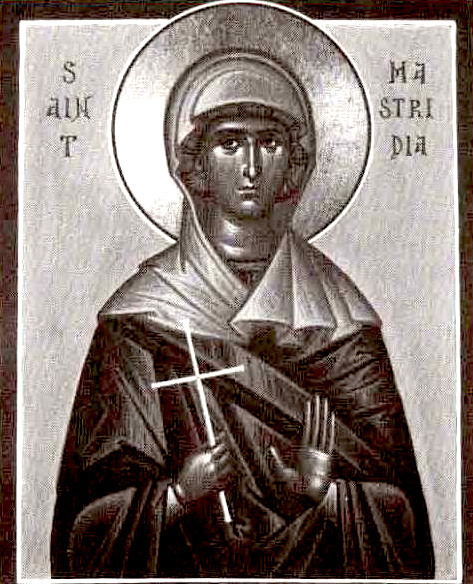
On February 7, the Orthodox Church celebrates the memory of a wonderful ascetic named Mastridia. She lived in Jerusalem, and very little is known about her life. In asceticism,
Mastridia desired to be united with our Lord Jesus Christ, , and spent many years attempting to achieve her goal. But before she started asceticism, she was courted by a certain impudent young man in Jerusalem who simply wouldn’t leave her alone. He kept harrassing her. He kept wanting to be with her. And she really didn’t want to.
At the same time, she also had great love for everyone and didn’t want to embarrass this young man. So she decided to go into the desert. She took a bowl of beans and put them in some water and carried it out into the desert. During the following years in this dry land, which was very rugged and very difficult, she reached incredible spiritual heights through her strict asceticism according to the will of the Lord. During that time, her beans never ran out. They were the only thing that she would eat. And the clothing, the garments, that she was wearing when she left, also never decayed.
She died in absolute divine radiance in the year 580 AD. She is not known to a lot of people, and there are probably many like her that are known only to the Lord. But yet the Lord has also given us but a brief glance into the life of this marvelous woman who loved Him so much she was convinced she could do all things in Him.
Source: Ancient Faith Ministries, Inc.


1 PETER 3:10-22
10 For "He who would love life And see good days, Let him refrain his tongue from evil, And his lips from speaking deceit. 11 Let him turn away from evil and do good; Let him seek peace and pursue it. 12 For the eyes of the LORD are on the righteous, And His ears are open to their prayers; But the face of the LORD is against those who do evil." 13 And who is he who will harm you if you become followers of what is good? 14 But even if you should suffer for righteousness' sake, you are blessed. "And do not be afraid of their threats, nor be troubled." 15 But sanctify the Lord God in your hearts, and always be ready to give a defense to everyone who asks you a reason for the hope that is in you, with meekness and fear;16 having a good conscience, that when they defame you as evildoers, those who revile your good conduct in Christ may be ashamed. 17 For it is better, if it is the will of God, to suffer for doing good than for doing evil. 18 For Christ also suffered once for sins, the just for the unjust, that He might bring us to God, being put to death in the flesh but made alive by the Spirit, 19 by whom also He went and preached to the spirits in prison, 20 who formerly were disobedient, when once the Divine longsuffering waited in the days of Noah, while the ark was being prepared, in which a few, that is, eight souls, were saved through water. 21 There is also an antitype which now saves us-baptism (not the removal of the filth of the flesh, but the answer of a good conscience toward God), through the resurrection of Jesus Christ, 22 who has gone into heaven and is at the right hand of God, angels and authorities and powers having been made subject to Him.
MARK 12:18-27
18 Then some Sadducees, who say there is no resurrection, came to Him; and they asked Him, saying: 19 Teacher, Moses wrote to us that if a man's brother dies, and leaves his wife behind, and leaves no children, his brother should take his wife and raise up offspring for his brother. 20 Now there were seven brothers. The first took a wife; and dying, he left no offspring. 21 And the second took her, and he died; nor did he leave any offspring. And the third likewise. 22 So the seven had her and left no offspring. Last of all the woman died also. 23 Therefore, in the resurrection, when they rise, whose wife will she be? For all seven had her as wife. 24 Jesus answered and said to them, "Are you not therefore mistaken, because you do not know the Scriptures nor the power of God? 25 For when they rise from the dead, they neither marry nor are given in marriage, but are like angels in heaven. 26 But concerning the dead, that they rise, have you not read in the book of Moses, in the burning bush passage, how God spoke to him, saying, 'I am the God of Abraham, the God of Isaac, and the God of Jacob'? 27 He is not the God of the dead, but the God of the living. You are therefore greatly mistaken.
#orthodoxy#orthodoxchristianity#easternorthodoxchurch#originofchristianity#spirituality#holyscriptures#gospel#bible#wisdom#saints
4 notes
·
View notes
Text




Theo Andreas Bailey
38 years of age. Greek. Translator & ancient languages consultant. Twin dad. Blue Harbor resident. ♿
thick and unruly hair, chewing mints, coffee and energy drinks beat water any day, unsolicited advices, secretly geek but proudly Greek, unreadable handwriting, crying over the library of Alexandria when drunk―just generally crying when drunk. Cursing medieval monks in the middle of the night, the sound of metal crutches on the floor, self deprecating jokes with a bittersweet layer of truth, poetry with shirts buttoned the wrong way― shirts unbuttoned all the way. Romantic with a capital R.
Wanted Connections & Full Biography
TLDR;
Born in Greece to unknown (and supposedly deceased) parents and raised at an orphanage.
Has cerebral palsy due to prematurity, affecting his legs. Uses mobility aids such as forearm crutches to get around as well as a wheelchair.
Adopted by the incredible academic and adventurous couple Dr. Jasmine and Richard Bailey at age 6, has lived all over the world growing up, especially between Egypt, England and Brazil.
Attended Cambridge University and led a very bohemian, lewd life. Drank a bunch. Made a lot of mistakes. Disappointed his parents and never reached his full potential.
A prodigious polyglot from infancy, has made translation his entire career, as a consultant in ancient languages.
Had a long term girlfriend who he broke up with before moving to Blue Harbor, where his family is currently residing. He's been in BP for about three years now.
Has recently found out that his mother is actually alive and well living as a nun in Greece.
He got his best friend, Dylan Westwick, pregnant and fell in love with her. Now he's a dad to twin babies, and are building a house by the lake. He wants (and should) propose soon.
PERSONALITY
"Mansplain, manipulate & manwhore."Dramatic and tragic, exaggerated and excessive, passionate, caring, sensitive, charming and eloquent, daydreamer and a visionary, procrastinator, chaotic, internally insecure yet externally confident, impulsive and genuine, self-deprecating and self-critical, troubled
INSPO.
Lord Byron . Percy Shelley . Cyrano de Bergerac (Cyrano) . Randall Pearson (This is Us) . Matt Murdock (Daredevil) .Jay Gatsby (The Great Gatsby). Dmitri Karamazov (The Karamazov Brothers)
DETAILS;
Theo Andreas Bailey was born prematurely in Greece and grew up at an orphanage in Athens. Due to his early birth and lack of proper medical care, he has cerebral palsy, affecting mostly his lower limbs and making him dependent on mobility aids, mainly forearm crutches and orthosis, but also a wheelchair.
He was adopted at age six by the Baileys, this insanely academically accomplished couple, who took him to England and would later adopt another child (Nilay). He struggles a little with his adoption --- he thought of himself a little like damaged goods, too old and too much trouble with his medical history, so he felt like he had to prove his worth. He kept putting pressure on himself to do better, always.
He was super skilled and insanely smart from an early age, picking up easily on multiple languages, but it backfired. The pressure built itself to the point where he started having panic attacks and seizures, which he (stupidly) tried to hide, again, not wanting to cause any trouble to his loving family.
Once he was a student in Cambridge, things changed drastically. Instead of chasing achievements, now he would drink too much, party too hard and neglect his studies. He was wasting his potential, everyone knew it --- he knew it. He did get a Masters and a PhD, though, in anthropological linguistics, because that’s what Baileys do.
Contrary to his family, he for a while he barely used his degrees and expertise. He works as an academic translator and lived an essentially empty life, hopping countries, drinking too much and not caring about a lot. He says it’s the ideal life and yet, deep down, he does that out of fear that by having a real job, in real academia, he would be bringing back his old habits and that way triggering his seizures and panic attacks.
He came to Blue Harbor after his sister and parents did. He’d been recently dumped by a long term girlfriend and was a little broken-hearted still. He had a mid-thirties crisis back in London when he looked at his life and saw nothing of substance there.
Recently found out that his birth mom is alive and a nun back in Greece, which shook him up a bit.
Got Dylan Westwick, his best friend, pregnant with twins due in January 2024, Leda and Lysander. Their relationship status is still very confusing, they're still trying to figure it out, but he's definitely proposing soon.
3 notes
·
View notes
Text
going through those early articles I've stumbled upon some mentions of the Music Tapes made only to compare other bands to it and usually as a butt of a joke. Which is fascinating because it is a sign of recognition - the band and its quirks must have been known well enough if various journalists thought it will be clear reference for their audience. Nevertheless, it's still sad and mean
like, see:

(from Austin American Statesman, 1 July 1999)


(from Flagpole, 29 December 1999)
images transcriptions:
[1st image] from Austin American Statesman, 1 July 1999:
Make Up, “I Want Some” — Unlike a lot of the modern-day psychedelic bands who think tinkering is tackling (the Music Tapes, anyone?), this Washington, D.C., quartet has the cool, sexy rhythms and clever grasp on songwriting to smoke your bongs. I had to make sure this K Records effort wasn’t really outtakes from the “Nuggets” box set. Zappa and Arthur Lee meets Prince meets Mudhoney. They’ll be at Emo’s Wednesday.
[2nd and 3rd images] from Flagpole, 29 December 1999:
TRAVIS NICHOLS' TOP TEN REASONS ATHENS WILL BE THE HOT SPOT FOR THE NEW MILLENNIUM
10. The continued evolution of the Athens music scene—from backwater dance pop to jangly guitar rock to neo-psychedelic home recorded freakouts to ambient instrumental jam rock to whatever some 15-year old Clarke Central kid is working on in his bedroom right now.
9. Have you ever been to other parts of Georgia? Good God!
8. Though it gave Stephen Malkmus diarrhea and wouldn't serve a poor Tibetan monk ground chuck, The Grit still has the best/biggest mother grabbin’ veggie burritos this side of the Andes.
7. While the services of lawyers, professors and middle managers are rapidly becoming obsolete due to the Great Disruption Information Decimation Boom, the service industry and the entertainment industry are increasingly providing the fuel for the global economy with jobs that can't be shipped overseas or replaced by software. So you there washing the dishes in the Green Day shirt, don’t look so glum: you are a precious commodity!
6. Neither Seattle nor Austin can touch our small-town charm.
5. Because if you can’t serve any real function in the world you might as well retreat from adult responsibility and hide under the guise of art/agoraphobia in a small town where no one will spit on you.
4. Because you get really tired around 2:45 a.m., anyway.
3. The continued biting wit of Flagpole letter writers.
2. Because when the dust settles on Jan. 1, 2000, a strange and terrible troupe of hellions will emerge from the rubble wearing tattered Jazz Fest T-shirts, blowing on kazoos and waving Muppet-like to the charred corpses on the ground—yes the Elephant 6 Millennium Cult will prevail, and if you don’t have proof you bought the Music Tapes record your ass will be up against the wall!
1. Come on, where else are you gonna go?
7 notes
·
View notes
Text
A Tolkien Perspective on Travel

"It's a dangerous business, Frodo, going out your door. You step onto the road, and if you don't keep your feet, there's no knowing where you might be swept off to."
J. R. R. Tolkien puts the aforementioned quote in the mouth of Gandalf in Fellowship of the Ring. It's a wonderful way to begin thinking about travel. While there are undoubtedly real dangers to guard against during one's travels, the warning given by Gandalf is ironic. His warning is not against the dangers of travel, but to watch out for the new passions and interests that are kindled within us through travel. Through the Grand Tour, KPA puts students in touch with some of the most beautiful, important, and inspiring artifacts of the Greco-Roman world. Walking through the acropolis, eating a souvlaki gyro with locally made tzatziki sauce, seeing Raphael's "School of Athens" four feet away, listening to monk's chanting and praying in a monastery -- these experiences have a way of not only conveying the reality of these things, but also revealing their beauty. Beauty is what draws us deeper into the object of study. I believe it is the beauty of the greater world that Gandalf is warning us. Since there are so many wonderful things you might encounter, Tolkien warns us that travels and adventures just might ignite a new desire within us.
Another well-worn Tolkien quote (probably among the top tattooed lines in the past 50 year) that is worth heeding is "Not all those who wander are lost." We are so busy and task-driven today that it is hard for us to make time just to wander and lose oneself in an adventure. During the Grand Tour, students have opportunities to wander, which yields plenty of wondering and pondering. In traveling we often leave behind hectic schedules and obligations and have more freedom to act leisurely. This enables us to pursue interests and unplanned opportunities to discover something new or to dwell more deeply on on something something that is familiar. This is not wasted time, and it is good remember that not all those who wander are lost. Some of us planned all along to wander without a pre-planned schedule.
The Grand Tour is an adventure. "Adventure," that's a term that Tolkien loved to describe something risky, yet profitable and good. Granted, his protagonists had adventures to confront evil and save the world from falling into darkness. KPA students are not going on the Grand Tour for that purpose. Nonetheless, we are taking a risk, we are sacrificing time and resources, to do something that we think is very profitable for the souls of our students. Indeed, for most it is a transformational trip. Students return changed from who they were when they left. Much like Tolkien's hobbits who risk going on an adventure outside of their safe and predictable homes and then return transformed with wisdom and virtue, I see students mature and grow through this trip. Their minds expand with new knowledge and experiences, their hearts grow with new loves and passions, and their souls are enlarged with maturity and wisdom through this new adventure. Let's have more adventures!
It is fitting to end with this final quote from Tolkien that reminds us that the current adventure is always just the beginning. "Don't Adventures Ever Have An End? I Suppose Not. Someone Else Always Has To Carry On On The Story.'"
6 notes
·
View notes
Text
BLOGGING FROM THE HASHTAG CLUBBBBBB
12 notes
·
View notes
Photo

Today we celebrate our Venerable and God-bearing Father Mark the Ascetic. Saint Mark was born in Athens in the fifth century. In his 40th year he was tonsured a monk by his teacher, St. John Chrysostom. Saint Mark then spent 60 more years in the wilderness of Nitria (a desert in Lower Egypt) in fasting and prayer, and in writing many spiritual works concerning the salvation of souls. He knew all the Holy Scriptures by heart. He was very merciful and kind, and wept much for the misfortunes that had befallen all of God's creation. On one occasion, when weeping over a hyena's blind whelp, he prayed to God and the whelp received its sight. In thanksgiving the mother hyena brought him a sheepskin. The saint forbade the hyena in the future to kill any more sheep belonging to poor people. He received Communion at the hands of angels. His homilies concerned such topics as the spiritual law, repentance, sobriety, and are ranked among the preeminent literature of the Church. These works were praised by the Patriarch Photius the Great himself. Nine of his thirty discourses have come down to us. Three of them are in Volume I of the English Philocalia. The Byzantines had such a high regard for his writings that they said, “Sell everything and buy Mark.” He was noted for his gentleness and purity of soul. He was known as “the Ascetic” because of his abstinence. He lived for ninety years as a solitary, then surrendered his soul to God when he was one hundred and twenty years old. May he intercede for us always + Source: https://orthodoxwiki.org/Mark_the_Ascetic (at Wadi El Natrun) https://www.instagram.com/p/CpYUIn-Ldbh/?igshid=NGJjMDIxMWI=
10 notes
·
View notes
Text
Ten Interesting Greek Novels
1. The Song of Achilles: A Novel by Madeline Miller
A tale of gods, kings, immortal fame, and the human heart, The Song of Achilles is a dazzling literary feat that brilliantly reimagines Homer’s enduring masterwork, The Iliad. An action-packed adventure, an epic love story, a marvelously conceived and executed page-turner, Miller’s monumental debut novel has already earned resounding acclaim from some of contemporary fiction’s brightest lights—and fans of Mary Renault, Bernard Cornwell, Steven Pressfield, and Colleen McCullough’s Masters of Rome series will delight in this unforgettable journey back to ancient Greece in the Age of Heroes.
“A captivating retelling of The Iliad and events leading up to it through the point of view of Patroclus: it’s a hard book to put down, and any classicist will be enthralled by her characterisation of the goddess Thetis, which carries the true savagery and chill of antiquity.” — Donna Tartt, The Times (Amazon.com)
2. Circe by Madeline Miller
In the house of Helios, god of the sun and mightiest of the Titans, a daughter is born. But Circe is a strange child--neither powerful like her father nor viciously alluring like her mother. Turning to the world of mortals for companionship, she discovers that she does possess power: the power of witchcraft, which can transform rivals into monsters and menace the gods themselves.
Threatened, Zeus banishes her to a deserted island, where she hones her occult craft, tames wild beasts, and crosses paths with many of the most famous figures in all of mythology, including the Minotaur, Daedalus and his doomed son Icarus, the murderous Medea, and, of course, wily Odysseus.
But there is danger, too, for a woman who stands alone, and Circe unwittingly draws the wrath of both men and gods, ultimately finding herself pitted against one of the most terrifying and vengeful of the Olympians. To protect what she loves most, Circe must summon all her strength and choose, once and for all, whether she belongs with the gods she is born from or with the mortals she has come to love. (Goodreads.com)
3. Zorba the Greek by Nikos Kazanzakis
First published in 1946, Zorba the Greek, is, on one hand, the story of a Greek working man named Zorba, a passionate lover of life, the unnamed narrator who he accompanies to Crete to work in a lignite mine, and the men and women of the town where they settle. On the other hand it is the story of God and man, The Devil and the Saints; the struggle of men to find their souls and purpose in life and it is about love, courage and faith. Zorba has been acclaimed as one of the truly memorable creations of literature—a character created on a huge scale in the tradition of Falstaff and Sancho Panza. His years have not dimmed the gusto and amazement with which he responds to all life offers him, whether he is working in the mine, confronting mad monks in a mountain monastery, embellishing the tales of his life or making love to avoid sin. Zorba’s life is rich with all the joys and sorrows that living brings and his example awakens in the narrator an understanding of the true meaning of humanity. This is one of the greatest life-affirming novels of our time. (Amazon.com) Part of the modern literary canon, Zorba the Greek, has achieved widespread international acclaim and recognition. This new edition translated, directly from Kazantzakis’s Greek original, is a more faithful rendition of his original language, ideas, and story, and presents Zorba as the author meant him to be. (Amazon.com)
4. The House on Paradise Street by Sofia Zinovieff
In 2008 Antigone Perifanis returns to her old family home in Athens after 60 years in exile. She has come to attend the funeral of her only son, Nikitas, who was born in prison, and whom she has not seen since she left him as a baby.
At the same time, Nikitas’s English widow Maud – disturbed by her husband’s strange behaviour in the days before his death – starts to investigate his complicated past. She soon finds herself reigniting a bitter family feud, and discovers a heartbreaking story of a young mother caught up in the political tides of the Greek Civil War, forced to make a terrible decision that will blight not only her life but that of future generations... (Amazon.com)
5. The Silence of the Girls: A Novel by Pat Barker
Here is the story of the Iliad as we’ve never heard it before: in the words of Briseis, Trojan queen and captive of Achilles. Given only a few words in Homer’s epic and largely erased by history, she is nonetheless a pivotal figure in the Trojan War. In these pages she comes fully to life: wry, watchful, forging connections among her fellow female prisoners even as she is caught between Greece’s two most powerful warriors. Her story pulls back the veil on the thousands of women who lived behind the scenes of the Greek army camp—concubines, nurses, prostitutes, the women who lay out the dead—as gods and mortals spar, and as a legendary war hurtles toward its inevitable conclusion. Brilliantly written, filled with moments of terror and beauty, The Silence of the Girls gives voice to an extraordinary woman—and makes an ancient story new again. (Amazon.com)
6. Ariadne by Jennifer Saint
Ariadne, Princess of Crete, grows up greeting the dawn from her beautiful dancing floor and listening to her nursemaid’s stories of gods and heroes. But beneath her golden palace echo the ever-present hoofbeats of her brother, the Minotaur, a monster who demands blood sacrifice. When Theseus, Prince of Athens, arrives to vanquish the beast, Ariadne sees in his green eyes not a threat but an escape. Defying the gods, betraying her family and country, and risking everything for love, Ariadne helps Theseus kill the Minotaur. But will Ariadne’s decision ensure her happy ending? And what of Phaedra, the beloved younger sister she leaves behind? (Amazon.com) Hypnotic, propulsive, and utterly transporting, Jennifer Saint's Ariadne forges a new epic, one that puts the forgotten women of Greek mythology back at the heart of the story, as they strive for a better world. (Amazon.com)
7. A Thousand Ships: A Novel by Natalie Haynes
This was never the story of one woman, or two. It was the story of them all . . .
In the middle of the night, a woman wakes to find her beloved city engulfed in flames. Ten seemingly endless years of conflict between the Greeks and the Trojans are over. Troy has fallen.
From the Trojan women whose fates now lie in the hands of the Greeks, to the Amazon princess who fought Achilles on their behalf, to Penelope awaiting the return of Odysseus, to the three goddesses whose feud started it all, these are the stories of the women whose lives, loves, and rivalries were forever altered by this long and tragic war.
A woman’s epic, powerfully imbued with new life, A Thousand Ships puts the women, girls and goddesses at the center of the Western world’s great tale ever told. (Amazon.com)
8. Elektra by Jennifer Saint
Three women, tangled in an ancient curse.
When Clytemnestra marries Agamemnon, she ignores the insidious whispers about his family line, the House of Atreus. But when, on the eve of the Trojan War, Agamemnon betrays Clytemnestra in the most unimaginable way, she must confront the curse that has long ravaged their family.
In Troy, Princess Cassandra has the gift of prophecy, but carries a curse of her own: no one will ever believe what she sees. When she is shown what will happen to her beloved city when Agamemnon and his army arrives, she is powerless to stop the tragedy from unfolding.
Elektra, Clytemnestra and Agamemnon’s youngest daughter, wants only for her beloved father to return home from war. But can she escape her family’s bloody history, or is her destiny bound by violence, too? (Amazon.com)
9. Clytemnestra: A Novel by Costanza Casati
As for queens, they are either hated or forgotten. She already knows which option suits her best…
You were born to a king, but you marry a tyrant. You stand by helplessly as he sacrifices your child to placate the gods. You watch him wage war on a foreign shore, and you comfort yourself with violent thoughts of your own. Because this was not the first offence against you. This was not the life you ever deserved. And this will not be your undoing. Slowly, you plot.
But when your husband returns in triumph, you become a woman with a choice.
Acceptance or vengeance, infamy follows both. So, you bide your time and force the gods' hands in the game of retribution. For you understood something long ago that the others never did.
If power isn't given to you, you have to take it for yourself.
A blazing novel set in the world of Ancient Greece, this is a thrilling tale of power and prophecies, of hatred, love, and of an unforgettable Queen who fiercely dealt out death to those who wronged her. (Amazon.com)
10. The Island by Victoria Hislop
On the brink of a life-changing decision, Alexis Fielding plans a trip to her mother’s childhood home in Plaka, Greece hoping to unravel Sofia’s hidden past. Given a letter to take to Sofia’s old friend, Fotini, Alexis is promised that through Fotini, she will learn more.
Arriving in Plaka, Alexis is astonished to see that it lies a stone’s throw from the tiny, deserted island of Spinalonga—Greece’s former leper colony. Fotini at last reveals the story that Sofia has buried all her life: the tale of her great-grandmother Eleni and her daughters, and a family rent by tragedy, war, and passion. Alexis discovers how intimately her family is connected with the island, and how secrecy holds them all in its powerful grip.
Atmospheric and captivating, The Island transports readers and keeps them gripped to the very last word. (Amazon.com)
2 notes
·
View notes
Note
Which Byzantine figures do you consider underrated? As someone who has slowly started to learn more about Byzantium, names like Constantine the Great, Justinian the Great, Theodora, Irene of Athens, Anne Komnene, Nikephoros Phokas, Constantine Palaiologos, Tsimiski, Basil, Zoe and Theodora Porprhyrogennita and Theophano are familiar, but do you have any other recommendations (sorry if I misspelled some)?
Below are a few Byzantine historical figures I find very interesting currently:

Flavius Belisarius (c.500 - 565)
While Justinian the Great is one of the most significant emperors in history, his accomplishments would simply not be the same, if he did not have Belisarius as his military commander. He was of uncertain descent (possibly Thracian, Illyrian or less so Greek) but his mother tongue was certainly Latin. Belisarius reconquered Rome and Italy while severely outnumbered during the Gothic War, defeated the Sassanids in the Iberian War, conquered the Vandal Kingdom in North Africa, successfully repulsed the Huns and defended the empire from the Persians and the Arabs. The Byzantine Empire reached its largest surface mostly thanks to Belisarius. A more controversial point in his life was when he was commanded to suppress the notorious Nika riots against Justinian, which ended in a massacre of dozens of thousands civillians. Belisarius was above all a strategist; he didn't mind fleeing the battle or using trickery in order to win a war. Despite his analytical mind in battle, he resolutely wasn't one in the affairs of the palace. Belisarius was married and quite smitten with Antonina, who had the favour of Empress Theodora, and thus felt safe to be totally unhinged. Schemes happening in the palace would sometimes find a scapegoat in Belisarius, who was likely the most genuinely devoted person to the emperor. As a result, Belisarius was often not treated well by the emperor and the secretaries and he was cheated on by his wife. He was even led to trial for betrayal, although Justinian eventually pardoned him. According to legend, Justinian first blinded him and then pardoned him, although lately the historicity of this is questioned. What's certain is that Belisarius didn't receive the respect he deserved in his personal life but he earned the respect of the historians, who consider him one of the best military leaders in history.
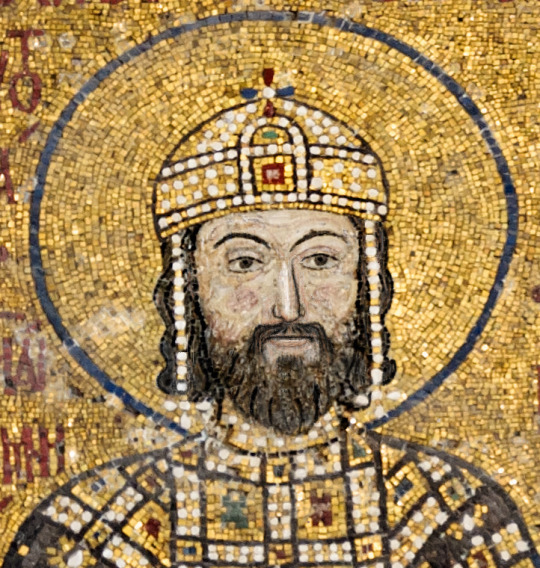
Ioannis II Komnenos (1087 - 1143)
Known as Kaloioannis (John the Good / Beautiful), Ioannis is considered the best emperor from the Greek dynasty of the Komneni. Ioannis was not beautiful, he must have been rather unattractive actually, but he earned the title because of his noble character. He was the brother of Anna Komnene, he was the one she tried to poison so that she would ascend to the throne instead. Ioannis forgave her. Ioannis was very just, modest and pious and would only use his imperial luxuries during diplomat visits. He was married to Irene of Hungary. Whether it was because of his piety, his natural predesposition or a different orientation, Ioannis was not very interested in the joys of marriage. However, he remained devoted and faithful to her. It is notable that during his long reign, not a single person was sentenced to death or mutilation, at a time that this would have been the norm for criminals and traitors. Despite all that, Ioannis was actually a great military leader once need arose. His biggest goal as an emperor was to undo the damage from the Battle of Manzikert 50 years prior. Indeed he forced Seljuk Turks to assume a defensive stance and did expand the empire's power to the east again. The Byzantine population increased during his reign. It is certain that Ioannis left the empire significantly better than how he received it. Some sources suggest that Ioannis' noble character was an inspiration to the people of his empire.

Michael Psellos (1017 - 1078)
Psellos was a Greek man of great knowledge and intellect and a questionable character. He did it all; he was a monk, a writer, a philosopher, a judge, a music theorist, an imperial advisor and courtier and a historian. His skill in literally everything led him quickly to the position of the leading professor in the University of Constantinople and that of secretary in the imperial court. His political influence was immense and he saw many emperors succeed each other while he maintained his position as political advisor. Because a big part of his work is autobiographical, it is unclear whether some of his claims are entirely reliable; Psellos was prone to vanity and sarcasm against those who did not favour him. Psellos studied Plato thoroughly, so much so that at times his faith in Christian Orthodoxy was questioned. *Fun fact: Psellos was apparently good at everything except Latin. His Latin was so rusty he confused Cicero with Caesar!
He looks like a Greek Rasputin in his painting above lol Anyway, he was manipulative but he wasn't nowhere near as controversial as Rasputin, let me be clear.
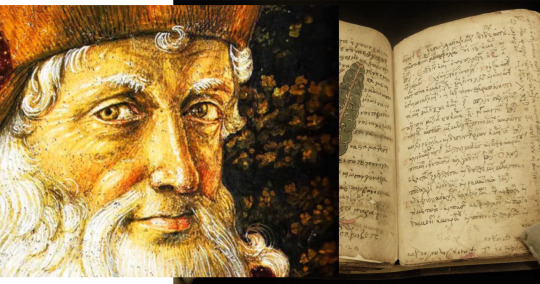
Georgios Gemistos Plethon (c. 1355 - 1452/1454)
Gemistos Plethon was a scholar and philosopher of the late Byzantine era. He was the pioneer of the revival of Greek scholarship in Western Europe. He was secretly not Christian, he believed in the Ancient Greek gods. Plethon admired Platon too. (It's Platon in Greek.) So much so that he added "Plethon" next to his surname Gemistos, which means pretty much the same thing (full) except more archaic and more similar to Plato(n)'s name! He was imperial advisor to the Palaeologi dynasty who at the time were reigning from Mystras, as the empire was dissolving. Everyone suspected his pagan beliefs but he was so influential and important that nobody dared confront him about it. He taught philosophy, astronomy, history, geography and classical literature. He was invited to Florence, Italy to teach Plato and Aristotle and help Florentines understand the differences between the two philosophies. Plethon died in Mystras shortly before or after the Fall of Constantinople. We don't know if he lived enough to see the empire fall. Around 10 years later, some of his Italian followers stole his remains from Mystras and interred him in Rimini, Northern Italy, so that he could "rest amongst free men". Plethon's vision was the revival of the Byzantine Empire, founded on a utopian Hellenic (and not universal) system of government. In one of his speeches, he said "We are Hellenes by race and culture". He is at the forefront of historical studies exploring the connections between Byzantine and Modern Greek identity.

Laonikos Chalkokondyles (c. 1430 - 1470)
Chalkokondyles was an Athenian native, from a prominent old family of the city. He was a historian who witnessed the last years of the Byzantine and the early years of the Ottoman Empire. He was sometimes employed by the Byzantine emperors as a messenger to the Sultan Mehmed II, not without drama. Chalkokondyles wrote in detail about 150 years prior to his lifetime. He described the fall of the Byzantine Empire, he offered a profile of the Ottoman Turks, and he wrote about their conquest of the Venetians and Matthias the King of Hungary. He also explored the civilisations of England, France and Germany. I didn't know about him until I read a great Romanian biography of Vlad Tepes the Impaler (you know, the inspiration of Count Dracula). Chalkokondyles's input is extensive and invaluable for this book; he wrote about Vlad's ancestors and the fights of the Wallachian princes with the Ottomans. His style of writing was mostly clear and simple, styled after Thucydides. He called the Byzantines “Hellenes” and did not use the term "Rhomaioi" (Romans in Greek) for them.
#byzantine empire#eastern roman empire#history#medieval history#middle ages#byzantine history#greek history#greeks#greek people#attichoney4u#ask#long post#tw long#long text#tw long text#tw long post
44 notes
·
View notes
Text
Today the Church honors St. Giles, Monk.
Ora pro nobis.
St. Giles (Aegidius in Latin, Egidio in Italian) is said to have been born in Athens c. AD 610. His piety and learning made him so conspicuous and an object of such admiration in his own country that, dreading praise and longing for a hidden life, he left his home and sailed for Gaul (France). At first he took up his abode in a wilderness near the mouth of the Rhône river, afterward near Arles close to the river Gard, and, finally, in a forest in the diocese of Nîmes in the south of France.
In this forest, he spent many years in the greatest solitude. It is told that his sole companion was a beloved red deer. Giles is also said to have only eaten a strict vegetarian diet. This retreat was finally discovered by the king's hunters, who had pursued his pet deer to its place of refuge, his hermitage. An arrow shot at the deer wounded the saint instead, having placed himself between the hunters and the deer. His wound healed but apparently left him with some form of disability. He afterwards became a patron of the physically disabled.
He spent many years in solitude, conversing only with God. Eventually, local the peoples learned of him and began to come to him for prayer. In time, the fame of his miracles became so great that his reputation eventually spread throughout Gaul. He was highly esteemed by the local Gallic king, but he could not be prevailed upon to forsake his solitude. He later admitted several disciples, however, to share it with him. He founded a monastery, and established an excellent discipline therein. In succeeding ages, the monastery embraced the rule of St. Benedict. St. Giles died c. AD 710.
Almighty God, you have surrounded us with a great cloud of witnesses: Grant that we, encouraged by the good example of your servant Giles, may persevere in running the race that is set before us, until at last we may with him attain to your eternal joy; through Jesus Christ, the pioneer and perfecter of our faith, who lives and reigns with you and the Holy Spirit, one God, forever and ever.
Amen.

2 notes
·
View notes